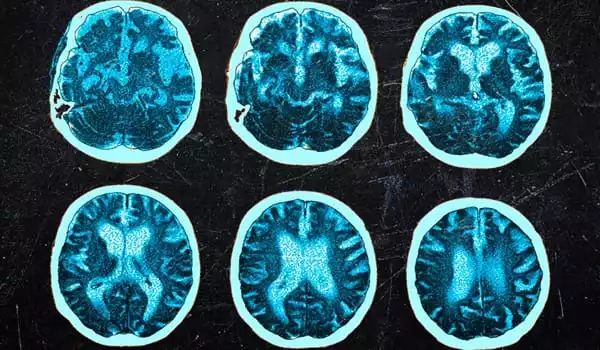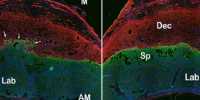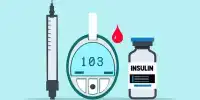A new study finds that patients hospitalized for COVID-19 had higher levels of blood proteins known to rise with neurological damage in the short term than non-COVID-19 patients diagnosed with Alzheimer’s disease.
Importantly, the current study, which was published online in Alzheimer’s & Dementia: The Journal of the Alzheimer’s Association, was carried out over two months before the pandemic began (March-May 2020). Long-term studies must be completed before determining whether patients with COVID-19 are at increased risk for future Alzheimer’s disease or recover over time.
The new study, led by researchers at NYU Grossman School of Medicine, discovered higher levels of seven markers of brain damage (neurodegeneration) in COVID-19 patients with neurological symptoms than in those without, and much higher levels in patients who died in the hospital than in those who were discharged and sent home.
A second study discovered that a subset of the damage markers in patients hospitalized with COVID-19 were significantly higher in the short term than in patients diagnosed with Alzheimer’s disease, and in one case were more than twice as high.
“Our findings suggest that patients hospitalized for COVID-19, particularly those experiencing neurological symptoms during their acute infection, may have levels of brain injury markers comparable to, or higher than, those seen in patients with Alzheimer’s disease,” says lead author Jennifer A. Frontera, MD, professor of neurology at NYU Langone Health.
Our findings suggest that patients hospitalized for COVID-19, particularly those experiencing neurological symptoms during their acute infection, may have levels of brain injury markers comparable to, or higher than, those seen in patients with Alzheimer’s disease
Professor Jennifer A. Frontera
Study Structure/Details
The current study identified 251 patients who, despite being 71 years old on average, had no history of cognitive decline or dementia prior to being hospitalized for COVID-19. These patients were then divided into two groups: those who had neurological symptoms during their acute COVID-19 infection and those who did not, depending on whether they recovered and were discharged or died.
The researchers also compared the COVID-19 group’s marker levels to those in the NYU Alzheimer’s Disease Research Center (ADRC) Clinical Core cohort, an ongoing, long-term study at NYU Langone Health. COVID-19 was not found in any of the 161 control patients (54 cognitively normal, 54 with mild cognitive impairment, and 53 with Alzheimer’s disease). Single molecule array (SIMOA) technology was used to measure brain injury, which can track minute blood levels of neurodegeneration markers in picograms (one trillionth of a gram) per milliliter of blood (pg/ml), which older technologies could not.
Three of the study markers, ubiquitin carboxy-terminal hydrolase L1 (UCHL1), total tau, and ptau181, are known measures of the death or disablement of neurons, the cells that allow nerve pathways to carry messages. Neurofilament light chain (NFL) levels rise when neurons’ extensions, or axons, are damaged. Glial fibrillary acidic protein (GFAP) is a marker of damage to glial cells, which support neurons. Amyloid Beta 40 and 42 are proteins that have been shown to accumulate in Alzheimer’s disease patients. Previous research suggests that total tau and phosphorylated-tau-181 (p-tau) are also specific measures of Alzheimer’s disease, but their role in the disease remains unknown.

Blood markers in the COVID patient group were measured in serum (the liquid part of blood that has been made to clot), whereas those in the Alzheimer’s study were measured in plasma (the liquid blood fraction that remains when clotting is prevented). The difference meant that NFL, GFAP, and UCHL1 levels could be compared between the COVID-19 group and patients in the Alzheimer’s study, but total tau, ptau181, Amyloid beta 40, and amyloid beta 42 levels could only be compared within the COVID-19 patient group (neuro symptoms or not; death or discharge).
Furthermore, toxic metabolic encephalopathy, or TME, was the primary measure of neurological damage in COVID-19 patients, with symptoms ranging from confusion to coma and caused during severe infections by toxins produced as the immune system overreacts (sepsis), kidneys fail (uremia), and oxygen delivery is compromised (hypoxia). In particular, the average percentage increase in levels of the seven markers for hospitalized patients with TME compared to those without neurological symptoms was 60.5 percent (figure 2 in the study). When comparing those successfully discharged from the hospital to those who died in the hospital for the same markers within the COVID-19 group, the average percentage increase was 124 percent.
A second set of findings came from comparing NFL, GFAP, and UCHL1 levels in COVID-19 patients’ serum to levels of the same markers in non-COVID Alzheimer’s patients’ plasma (figure 3). NFL levels in COVID-19 patients were 179 percent higher (73.2 versus 26.2 pg/ml) than in Alzheimer’s patients in the short term. GFAP levels in COVID-19 patients were 65 percent higher (443.5 versus 275.1 pg/ml) than in Alzheimer’s patients, while UCHL1 levels were 13 percent higher (43 versus 38.1 pg/ml).
“Traumatic brain injury, which is also associated with increases in these biomarkers, does not guarantee that a patient will develop Alzheimer’s or related dementia later on,” says senior author Thomas M. Wisniewski, MD, Gerald J. and Dorothy R. Friedman Professor of Neurology and director of the Center for Cognitive Neurology at NYU Langone. “Whether that kind of relationship exists in those who survive severe COVID-19 is an urgent question that we need to answer with ongoing monitoring of these patients.”
















